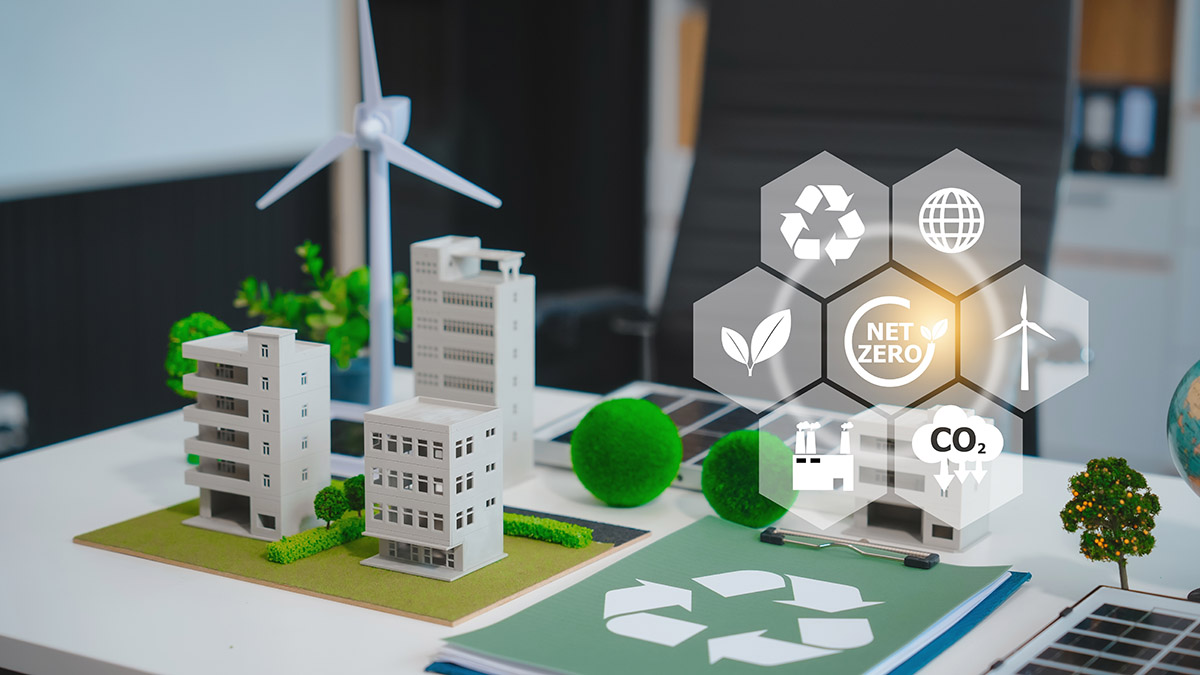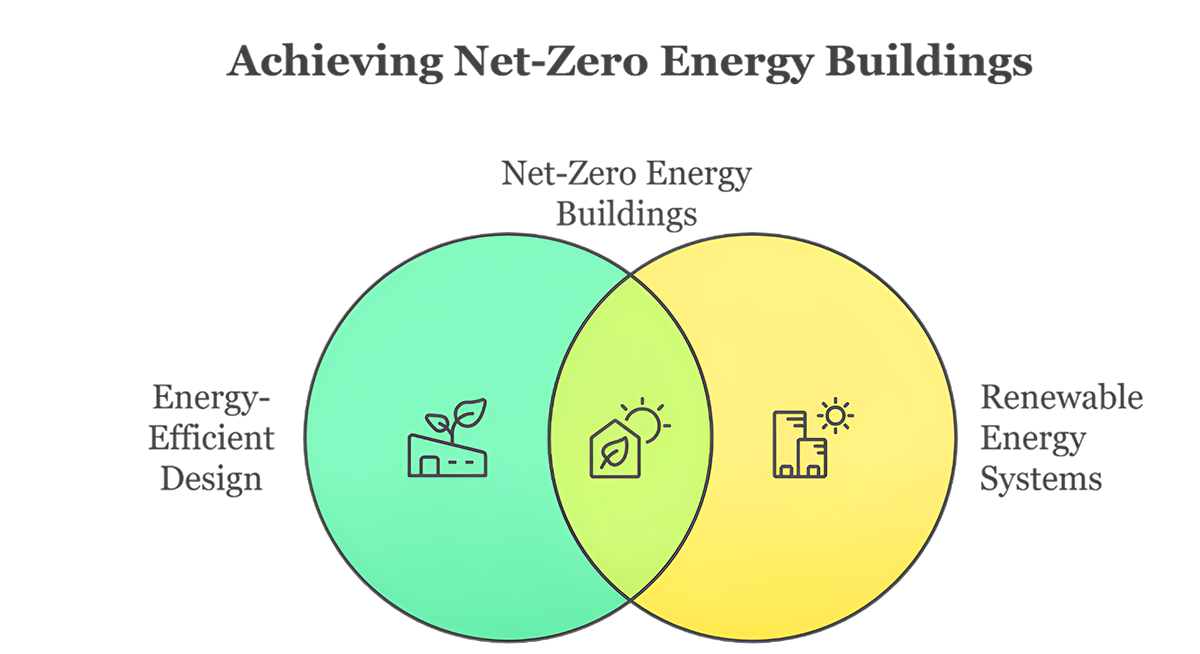Buildings play an essential role as India’s urban population–along with constructed buildings–is projected to increase nearly fourfold in the year 2050.

Each year, India witnesses large-scale rural-to-urban migration. This makes the country undergo rapid urban expansion that alters its physical landscapes, economic systems, and even social dynamics. Though urban growth promises opportunities for improved employment options, better educational facilities, and advanced medical care infrastructure, it strains existing energy and water distribution systems along with the infrastructure base. To support this growing population and the stress it brings, our cities need smarter, more resilient infrastructure that can keep up with the pace of change.
Transforming Urban Infrastructure
India’s building sector consumes about one-third of the country’s electricity and contributes significantly to emissions through lighting and cooling operations together with building construction activities and material production. Climate change causes heatwaves, depletes water reserves, and intensifies severe weather patterns, thus disbalancing overall urban infrastructural stability thereby increasing energy demand and resource wastage.
The traditional approach of merely increasing construction numbers must be replaced by constructing buildings that are both environmentally sustainable and architecturally efficient in enhancing climate resilience. The net-zero energy buildings (NZEBs) represent structures that meet their total annual operational energy needs — including heating, cooling, lighting, and appliances — by producing an equal amount of on-site renewable energy while using climate-resilient designs to support sustainable urban development. With this approach, Indian cities can achieve a balance between meeting current urban requirements and environmental climate resilience by integrating passive cooling, high-performance envelopes, smart energy controls, and renewable technologies from the project conception stage.
Understanding Net-Zero Energy Buildings
The net-zero energy buildings generate their entire required power through renewable energy resources, including solar power and wind power. The annual energy balance — where a building’s total annual energy consumption is offset by an equal amount of on-site renewable energy generation — reaches net ‘zero’ by first minimizing energy demand through efficient design and then meeting the remaining needs with renewables, thereby reducing environmental emissions. The integration of energy-efficient design, advanced materials (aerogels, cross-laminated timber, etc.), smart controls, and renewable energy systems, enables the NZEBs to operate at net-zero energy. Although the application of NZEBs (Figure 1) in India is still in its nascent stages, it is rising rapidly. The government recognizes that ensuring energy efficiency is essential to meet climate goals. In this context, India has two major climate commitments, which include reaching net-zero emissions by 2070 and reducing its carbon intensity by 45% from 2005 levels by 2030.
 Figure 1: Visual representation of how to achieve NZEBs
Figure 1: Visual representation of how to achieve NZEBs
NZEBs: Cutting Urban Carbon Footprints
Buildings play an essential role as India’s urban population–along with constructed buildings–is projected to increase nearly fourfold in the year 2050. Conventional buildings consume most of their energy on heating, cooling, lighting, and plug-loads. The existing Indian buildings that depend on fossil fuel systems with inefficient devices and poor insulation create energy inefficiency and environmental pollution through excessive energy consumption. The passive design features in NZEBs, including the optimal building alignment and building ventilation methods alongside daylighting utilization, work together to reduce the need for artificial Heating, Ventilation and Air-Conditioning (HVAC) systems. Energy-saving devices, such as smart management systems, efficient HVAC units, refrigerators, washing machines, and LED lighting solutions, significantly decrease a building’s electricity consumption. Solar photovoltaic (PV) panels stand as the primary renewable energy solution that communities choose for NZEBs because of the country’s abundant sunlight. Solar power produced within the building decreases energy consumption from traditional power grids and fossil fuels, thus minimizing carbon dioxide (CO2) emissions from urban areas.
Policy and Regulatory Support in India
Currently, the Government of India is expanding its policy framework to boost the adoption of NZEBs. All new commercial buildings must meet the minimum energy-efficiency standards set by the Bureau of Energy Efficiency’s (BEE) ‘Energy Conservation Building Code’ (ECBC). Several states such as Uttar Pradesh, Punjab, Karnataka, and Telangana have already adopted and adapted to ECBC as per local contexts, encouraging developers to construct more energy-efficient buildings. Net-zero energy design has become a recommended practice according to the Green Rating for Integrated Habitat Assessment (GRIHA), the Indian Green Building Council (IGBC), and other certifying bodies in the country. The Government of India is also implementing both the Smart Cities Mission (SCM) and Atal Mission for Rejuvenation and Urban Transformation (AMRUT) to develop sustainable infrastructure through the building of energy-efficient structures.
Climate Resilience: Beyond Energy Efficiency
While reducing energy use and emissions is vital, buildings must also resist the adverse effects of climate change. Shifting climate patterns pose serious threats to India’s urban infrastructure and ecosystems. A building designed for climate resilience must withstand shock events and stress that result from climate change. The use of durable materials, flood-resistant construction methods, and heat-island mitigation is, therefore, essential. The combination of green roofs with reflecting surfaces and more vegetation decreases building temperatures while reducing heating requirements inside the structure. Together, these measures enable buildings to remain low-carbon and resilient under climate stress. A method like this can prove beneficial for building cities capable of adapting to extreme climatic conditions, such as heatwaves, flooding, droughts, and intense storms.
Innovations in India
India has multiple developments that demonstrate the technological potential for constructing net-zero buildings that can sustain and are resilient to climate change risks. For instance, a government facility in New Delhi, named Indira Paryavaran Bhawan, employs passive solar architecture combined with energy-saving technologies and photovoltaic (PV) panels on its rooftop. This framework now serves as a design template for other public buildings. Additionally, this facility is recognized as one of India’s highest-rated green buildings. The project has received both GRIHA 5 Star and Leadership in Energy and Environmental Design (LEED) Platinum certifications.
Today, educational institutions, together with private developers, are constructing buildings to meet NZEB standards. For example, the Indian Institute of Technology (IIT) Madras operates with energy-efficient buildings that integrate solar power systems and smart energy control technology; Pune and Ahmedabad have incorporated green building requirements into their urban development plans to boost energy efficiency. When Indian buildings implement appropriate regulations coupled with modern technology and public awareness, NZEB adoption rates in India will increase.
The Way Forward: Challenges and Opportunities
Despite the promise of NZEBs, various challenges must be overcome to expedite their implementation in India. These are: Awareness & Capacity: Train architects, builders, and end users on NZEB design principles. Financing & Incentives: Develop green loans, subsidies, and public-private partnerships to offset higher upfront costs. Technology Access: Ensure affordability and wider availability of advanced materials, renewable systems, and smart control technology. Policy Enforcement: Strengthen ECBC/Energy Conservation and Sustainability Building Code (ECSBC) compliance and integrate resilience into urban planning. Enabling Environment: Leverage India’s climate commitments, expanding renewables, and urban missions to support NZEB growth.
Conclusion
Net-zero energy buildings represent more than standard technical enhancements since they establish innovative guidelines for Indian urban dwellings. Energy-positive architectural design along with adaptive features in these structures can reduce operational energy requirements as well as emissions, thereby improving occupant comfort during power outages. Green infrastructure systems working with integrated water management can create urban areas that resist extreme events, such as floods and droughts. These demonstration projects act as drivers to create a market demand for sustainable materials and smart technologies, which simultaneously decrease lifecycle expenses and improve asset worth. Therefore, NZEBs provide a framework that enables national governments, financial supporters, development entities, and residential communities to work together in building resilient Indian cities that will endure for generations.
